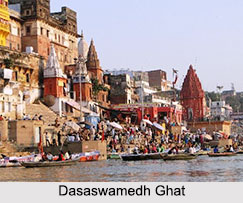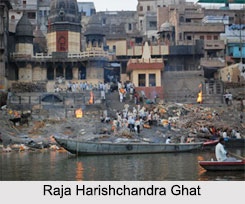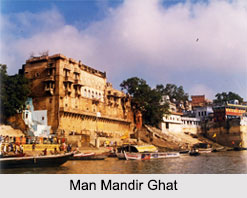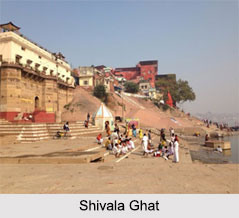 Ghats of Varanasi are regarded as the holiest pilgrimage places in the city of Varanasi, Uttar Pradesh. There are almost 100 ghats here that are visited by pilgrims who crowd the place to take a dip in the holy Ganga River in order to wash off all their sins.
Ghats of Varanasi are regarded as the holiest pilgrimage places in the city of Varanasi, Uttar Pradesh. There are almost 100 ghats here that are visited by pilgrims who crowd the place to take a dip in the holy Ganga River in order to wash off all their sins.
Some of the important ghats of Varanasi are Dasaswamedh Ghat, Mani Karnika Ghat, Assi Ghat, Ganga Mahal Ghat, Rewan Ghat, Tulsi Ghat, Raj Mandir Ghat, Badhani Ghat, Janaki Ghat, Mata Anandami Ghat, Vachharaja Ghat, Dattatreya ghat, Beni Madhav Ghat, Durga Ghat and Brahma Ghat, Rewan Ghat, Amrit Rao Ghat, Someswar Ghat, Narad Ghat, Vaccharaja Ghat, Dandi Ghat, Hanuman Ghat, Jain Ghat, Nishad Ghat, Prabhu Ghat, Panchkota Ghat, Chetan Singh Ghat, Niranjani Ghat, Mahanirvani Ghat, Gularia Ghat, Lai Ghat, Gai Ghat, Narayan Ghat, Trilochan Ghat and Naya Ghat lead to Prahlad Ghat.
Hindu Mythology on Varanasi
According to the Hindu mythology, Varanasi liberates soul from human body to the ultimate. It is thus believed that by bathing in these ghats one can get rid of the cycle of birth and death. Few of the ghats here were built when the city was under the reign of the Marathas. Most of the ghats are bathing ghats, while others are used for cremation.
Raj Ghat
Raj Ghat is the end of the city and if devoid of any religious significance it always presents a busy appearance, because all vehicular traffic from the other side of the river passes into the city through this spot, bringing goods of various kinds to its busy markets.
Dasaswamedh Ghat
Dasaswamedh Ghat is considered one of the five great teerths of Varanasi. According to Hindu mythology Lord Brahma performed ten ashwamedha or horse-sacrifices at the spot. The ghat has many temples that attract thousands of devotees.
Mani Karnika Ghat
Mani Karnika Ghat is basically a cremation ghat. It is divided in to two parts. The first section is used for cremation and the second section for the sacred baths. This ghat symbolizes creation and destruction. Manikarnika Kund is a sacred well located at the Manikarnika Ghat.
Panchganga Ghat
 Panchganga Ghat is basically a convergence of rivers of Ganga, Saraswati, Dhupapapa, Yamunaand Kirna. This is also the place where Alamgir Mosque was built by Mughal ruler Aurangzeb.
Panchganga Ghat is basically a convergence of rivers of Ganga, Saraswati, Dhupapapa, Yamunaand Kirna. This is also the place where Alamgir Mosque was built by Mughal ruler Aurangzeb.
Tulsi Ghat
Tulsi Ghat also known as Lolark Ghat has been named after the famous Hindu poet of the 16th century, Tulsidas. The poet composed the famous scholarly religious work Ramcharitmanas at Varanasi.
Assi Ghat
Assi Ghat is situated at the confluence of Ganga River and Assi River. A huge Shiva lingam is situated under a peepal tree here. Assi Ghat has also been mentioned in Matsya Purana, Agni Purana, Kurma Purana, Padma Purana and Kashi Khanda.
Harish Chandra Ghat
Harish Chandra Ghat is a cremation ghat. It is believed that if a person is cremated at the Harish Chandra Ghat he attains Moksha. A temple of Bhutanath with Bhageswari Devi is present here.
Scindia Ghat
Scindia Ghat, also known as Shinde Ghat borders the Mani Karnika Ghat in the north side. It was built by Baija Bai. Above the ghat there are several temples. It is known for the massiveness of its masonry.
Adi Keshava Ghat
Adi Keshava Ghat was earlier referred to as Vedesvara Ghat in the Ghadavala inscription. It is set on the banks of Varana River and Ganga River.
Mira Ghat
 Mira Ghat was named after a noble person named Mira Rustam Ali. In 1735 he had built the steps and platform. Mira Ghat was the original site of Jarasandheshvara and Vrdhaditya temples.
Mira Ghat was named after a noble person named Mira Rustam Ali. In 1735 he had built the steps and platform. Mira Ghat was the original site of Jarasandheshvara and Vrdhaditya temples.
Barna Sangam Ghat
Barna Sangam Ghat situated in the north eastern, boundary is a highly venerated spot. Above the steep bank of the ghat there are four temples installed with the idols of Lord Shiva, Lord Brahma, Lord Hanuman and others.
Kedar Ghat
The temple of Kedareshwar is located on Kedar Ghat. Prachina Mani karnika is also present here. This was constructed by the Maharaja of Vijayanagar in the southern part of Kashi.
Tripura Bhairavi Ghat
Temple of Tripura Bhairavi is present on Tripura Bhairavi Ghat.
Hanuman Ghat
Hanuman Ghat has a temple dedicated to Lord Hanuman. Hanuman Ghat is where Vallabha Acharya is said to have been born in the 16th century. He was a Vaishnava saint who spread the glories of Lord Krishna.
Manasarovar Ghat
Manasarovar Ghat is named after the holy lake which is found at the foot of Mount Kailash. It was built by Man Singh of Jaipur.
Chaumsathi Ghat
Chaumsathi Ghat has a temple dedicated to the Chaumsathi (64) Yoginis, which has deities of Goddess Durga and Goddess Kali.
Someswara Ghat
Someswara Ghat has a temple of the moon. It is thought that by bathing here every type of disease is supposed to get healed here.
Munshi Ghat
Munshi Ghat was named in memory of Sridhar Narayan Munshi, a financial minister of Nagpur State who resigned his job in 1812 and passes his last periods of life in Varanasi and died in 1824.
Man Mandir Ghat
 Man Mandir Ghat was built by Maharajah Man Singh of Jaipur in 1600. It has an Observatory built by Raja Sawai Jai Singh in 1710, the founder of the city of Jaipur. The observatory is made up of stone instruments. A Siva-linga temple temple is also located near to the ghat.
Man Mandir Ghat was built by Maharajah Man Singh of Jaipur in 1600. It has an Observatory built by Raja Sawai Jai Singh in 1710, the founder of the city of Jaipur. The observatory is made up of stone instruments. A Siva-linga temple temple is also located near to the ghat.
Mir Ghat
Mir Ghat has the temple of Vishalakshi. This temple is one of the Shakti Peethas and is said to mark the place where a part of the body of Sati, the wife of Lord Shiva, fell.
Lalita Ghat
Lalita Ghat houses a Nepali Temple dedicated to Pashupateswara Shiva. It is a Nepali type wooden temple which has many attractive sculptures. Also here is a Vishnu temple dedicated to Ganga Keshava.
Jalasayin Ghat
Jalasayin Ghat is a cremation ghat. It is located beside the Manikarnika Ghat.
Rama and Laksman Ghat
Rama and Laksman Ghat has a temple dedicated to Lord Rama and his brother Lakshmana.
Trilochan Ghat
Trilochan Ghat houses the Shiva temple of Tri (three) Lochana (eye). The temple of Varanasi Devi, the city-goddess of Varanasi is also located here.
Bhadaini Ghat
Bhadaini Ghat is located close to Janki Ghat. It got its name from the famous sun shrine.
Raj Ghat
Raj Ghat is the northern most ghat. The Adi Keshava Vishnu Temple is located here. Lord Vishnu is said to have first put his feet here when he came to Varanasi.
Ganesha Ghat
It was built by the Peshawar of Pune. It has a narrow flight of steps with the quaint name of Chor Ghat apparently intended to emphasise the facilities the place provided to the thief.
Shivala Ghat
Shivala Ghat has been separated into some small ghat. At present one witnesses a colossal building constructed by Nepal King Sanjay Vikram Shah. A Shiva temple and one Brahmendra Math were established here by Kashiraj.



















